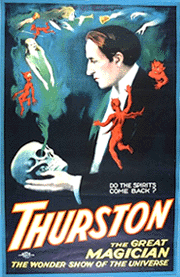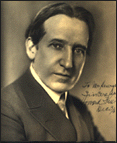October 1996
 |
Ladies and Gentlemen.
The Million Dollar Mystery.An 18 inch square box mounted on four iron legs is brought to center stage. The top, bottom and sides are all of frosted glass. The sides are open for your inspection and then closed. Twelve ping pong balls are thrown into the box. The bottom door opens and hundreds flood to the stage. The box is shown to be empty once more. Attention is called to a block of wood, six feet long by fifteen inches square. The block is wheeled to the side of the box and then shoved inside. The side door closed, the front of the box is opened where again emerges the six feet of wood. Suddenly, a beautiful girl jumps out of the box. The box is shut again. Grotesque hands and faces begin to appear against the frosted glass panels. With a haunting wail, the top of the box flies open and a red devil rises above the stage.
Lithograph Poster: Do the Spirits Come Back?/Thurston the Great Magician / The Wonder Show of the Universe
Maker: Otis Lithograph Co., Cleveland, OH
Date: ca.1930 ID: 93.0.53.1
|
|
One of four boys born to a carriage maker in Columbus, Ohio, Howard Thurston would become one of the most popular magicians in America. Along with Harry Houdini, T. Nelson Downs, and Horace Goldin, Thurston would dominate the theatrical era during the first quarter of the twentieth century before the prominence of radio and the motion picture. Born in 1870, Howard Thurston began doing card tricks at a young age. Throughout his career, he always kept a card routine in his show. It was not long before he began experimenting with illusions. Working his way through tent shows and vaudeville, he took his own show on a world tour in 1907. The following year, he joined the great American magician Harry Kellar. On his farewell tour in 1908, Kellar introduced Thurston as his successor. |
|
Through the teens and twenties, Thurston toured his show of illusions across the country and around the world delighting audiences with the Tubes of Tubal, the Dido Illusion, the Levitation of Princess Karnac, and the Million Dollar Mystery. The show could range from the exotic, such as the East Indian Rope Trick (with real Indian conjurers!), to the fantastic in the everyday, such as a vanishing Willys-Overland automobile. A thirty-third degree mason, his show often contained words associated with Masonic ritual. And although he never actually became a minister, Thurston would often address Sunday services in the town where he was appearing that week. Always, the great magician acted as the liaison between our world and the world of illusion. He played the part of the storyteller, making the psychological connection between himself and the audience, gently persuading them to suspend their disbelief and accept his world of hypnotized princesses and palatine spirits, villainous devils and ancient phantoms. |

Howard Thurston,
ca. 1933
|
| The early 1930s faced the decline of road shows in America. Boston's Tremont Theater saw Thurston's last great full evening show in April of 1931. He decided he would adapt to the new theatrical conditions of the 1930s, playing stages in movie houses. He selected all of his best and most complex tricks and increased the timing of the entire show. He was now doing four shows a day as opposed to the ten performances a week of the old days. His assistants begged him to cut back, to make the show easier on himself. In 1935, Thurston suffered a cerebral hemorrhage during a performance in Charleston, West Virginia. On March 20, 1936 he suffered a second stroke and died on April 13 at the age of 66.
If you would like to know more about our poster collection of Thurston the Great Magician, please contact the Research Center. |
[ Pic of the Month ] [ Pic Archive ]
|

